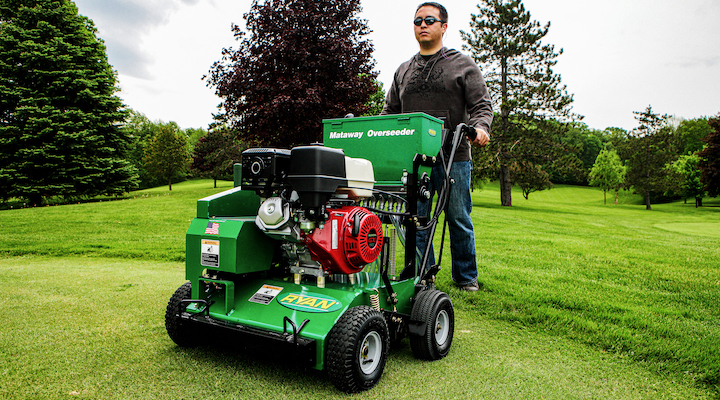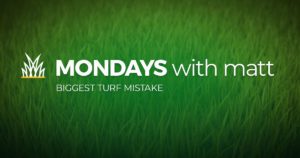LAWN OVERSEEDING
Give your lawn thicker growth, better color, and greater resistance to disease and drought!
WHAT IS OVERSEEDING?
Overseeding is the planting of grass seed directly into existing turf, without tearing up the turf, or the soil. It’s an easy way to fill in bare spots, improve the density of turf, establish improved grass varieties and enhance your lawn’s color.
If a lawn looks old, or just “worn out,” if it needs growing amounts of water and fertilizer to thrive, or is disease or insect prone, it’s a perfect candidate for overseeding.
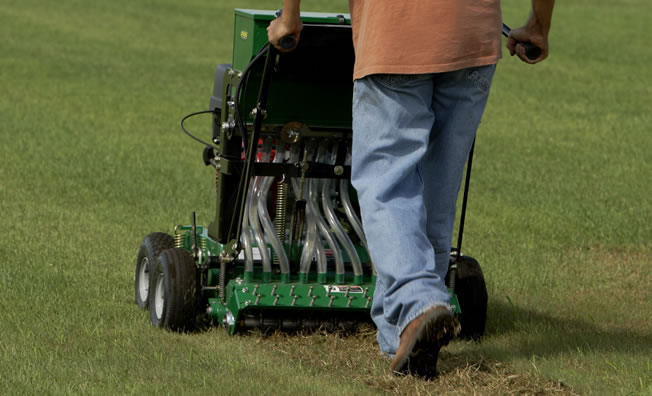
THE BENEFITS OF OVERSEEDING
Many older lawns were established with common type turf grasses not suited for the needs of today’s homeowner. They’re often more disease and insect prone, requiring more fertilizer and water.
Overseeding newer turfgrass varieties into an older lawn can help it better withstand insects, disease, drought, shady conditions and heavy traffic. The investment in overseeding pays off by reducing the amount of fertilizer, water and pesticides required. Most importantly, a renovated lawn stays greener and looks thicker and healthier!
BEFORE YOU OVERSEED
For various reasons, old turf sometimes deteriorates dramatically or dies out completely. Overseeding with an improved grass seed mixture can get new turf growing in bare areas as well as “sprucing up” areas where the turf is thin and unhealthy looking.
First, however, you must analyze the problems that caused the original turf to deteriorate. It might be due to conditions that, if not corrected, will eventually cause the overseeded lawn to deteriorate, too.
Correctable problems include:
- Poor soil condition
- Improper drainage
- Soil compaction
- Insufficient water
- Poor fertility
- Poor air circulation
- Insufficient sunlight
- Excess thatch
- Grass varieties not suitable for the area
- General neglect
If you have trouble identifying the problem, ask your local lawn professionals or your county extension office. The main thing is to correct the problem before you establish new grass.
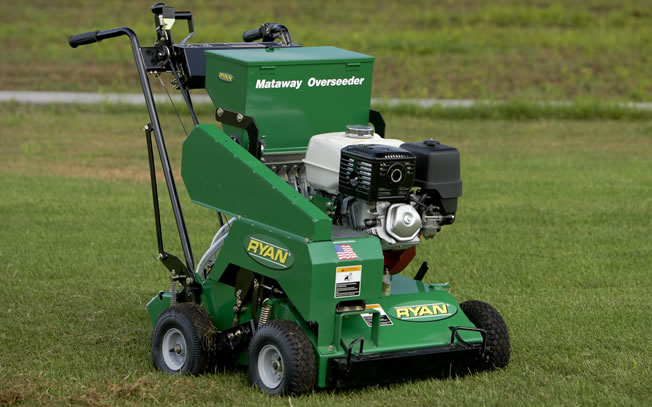

OVERSEEDING METHODS
Slit-seeding with a mechanical slit-seeder
This is the best method for overseeding established turf. Slit-seeders such as the Ryan® Mataway®Overseeder have verticutting blades that cut through the thatch layer and open up a slit or miniature furrow in the soil. The depth of the slit or miniature furrow is based on the type of grass seed used. A general rule of thumb is to go no deeper than half the length of the grass seed husk. The slit-seeding unit should have concave disk blades that follow in the slits and keep them open while the seed is dropped; it ensures the seed gets into the soil where it can germinate.
Slit-seeding generally takes less seed than broadcast seeding, because most of the seed gets into the soil so it can germinate. More seed-to-soil contact means a higher germination rate and a thicker better looking new turf.
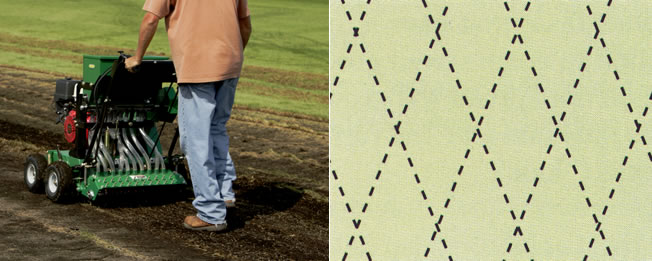

We recommend making two passes with the Ryan® Mataway® Overseeder, seeding at 50% of the recommended rate. Make the two passes at a 45° angle to each other, leaving a diamond-shaped pattern (see illustration). This method is fast, and results in the seed being placed a maximum of 2 inches apart.
A “full” cover will be produced faster, even with grasses that do not spread. Some overseeders drop seed in 3-inch rows which will give a striped appearance to the lawn.
Note: Before overseeding, check your lawn for thatch. If the thatch is more than 1/2-inch thick, dethatch before seeding. This can be done effectively with the Ryan® Mataway® Dethatcher or the Power Rake.
Broadcast seed with a cyclone or drop-type seeder
This second method of overseeding is also effective, if you’re unable to use a slit-seeder. Aerate several times before broadcasting seed; aeration holes should be spaced not more than 2-3 inches apart. Use core-type aerating tines that remove soil plugs for better seed-to-soil contact. After overseeding, give the area a heavy watering right away to wash seed into the aeration holes and help break up the aeration cores on the surface.
One challenge with broadcast seeding is that much of the seed gets “hung up” in the thatch layer and does not get into the soil where it can germinate. Be sure to use grasses (such as bluegrass) that have a “creeping” growth method to ensure even growth; grass types that do not spread will grow in the aeration holes only and give the turf a “clump” or “spotted” look. Remember broadcast seeding requires more grass seed and the germination rate is not as high as with slit-seeding.
WHAT ABOUT CARE AFTER OVERSEEDING?
Depending on conditions and type of seed, new grass seed will begin to emerge in 5-7 days after seeding when moisture and soil temperatures are adequate. An overseeded lawn can be fully established in eight weeks or less.
Proper watering is critical to successful overseeding. The following is a recommended watering program.
- Immediately after overseeding: Water heavily to wash grass seeds into slits.
- Until grass seeds germinate (first 10-14 days): Water lightly on a daily basis, soaking first one inch of soil.
- After germination: Water less frequently, but allow for deeper soaking and penetration into soil. This encourages deeper root growth.
- After grass becomes established: Water at the recommended level for the type of grass planted.
The key is care and patience. Proper overseeding will produce a healthier, better-looking lawn that responds better to mowing, fertilizing and watering. An added benefit is increased property value!
CASE STUDY
The following photographs show a complete renovation that was done using proper overseeding equipment and procedures.
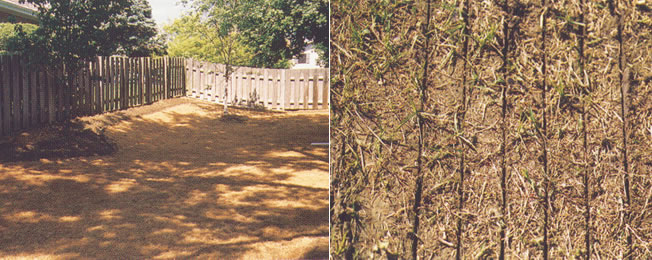

Home lawn, 25 years old. Overrun with fescue. Homeowners desired bluegrass. Roundup® Pro was applied to kill remaining growth
Slit seeded lawn.80% Kentucky Bluegrass was planted in rows. Light watering began immediately.
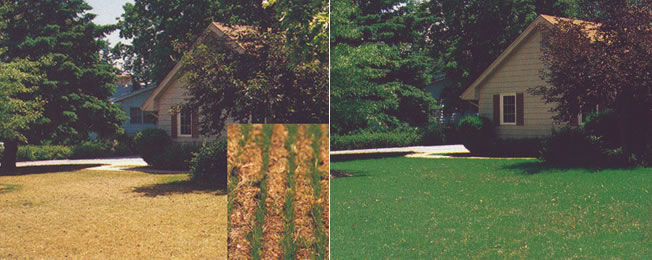

Two weeks later, the germination rate is excellent. The row-crop effect of the slit-seeder fills nicely.
After 5 weeks, the lawn is filling in nicely. Customers are very satisfied with their decision to overseed.
WHEN IS THE BEST TIME TO OVERSEED?
Late summer or early fall is the best time to overseed lawns. Soil and atmospheric temperatures are most favorable for optimum seed germination and growth. With adequate moisture, fertilizer and sunlight, the new seedlings will be well established before cooler fall weather sets in. Also, weed competition is less of a factor at this time, giving the grass seedlings a better environment to grow and develop.
Spring overseeding risks the chance of weather-related problems (heavy spring rains, unexpected high temperatures) and weed competition. Also, spring seeding may interfere with the application of preemergent crabgrass or broadleaf weed killers; concurrent application of seed and herbicides is generally not recommended because the herbicides may cause poor seedling establishment. It is best to delay herbicide treatment 4-6 weeks after new grass seed germinates. If you choose to overseed in the spring, be sure to follow proper seeding and treatment practices.
Midsummer overseeding faces greater chances of disease, heat and drought stress, and weed competition. Proper weed control and adequate irrigation are musts if overseeding is attempted in midsummer.
Dormant overseeding involves seeding in late fall or early winter, after soil temperatures are low enough to prevent seed germination.
Success usually requires good snow cover during the winter, to prevent wind or water erosion and ensure germination doesn’t begin too early. This method is sometimes preferred over spring seeding, especially in northern areas, because you don’t have to wait for soil or moisture conditions to improve before overseeding.
Note: When overseeding Bermudagrass in southern parts of the U.S., late spring or early summer seeding usually works best. Bermudagrass and other warm-season grasses need warmer weather to germinate and fully develop.
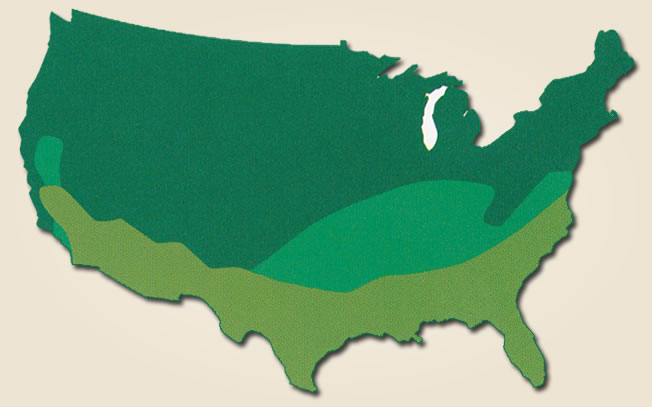

Areas of Turfgrass Adaptation


Kentucky Bluegrass, Perennial Ryegrass, Fine Fescue


Tall Fescue, Zoysiagrass; Common Bermudagrass


Tall Fescues, Hybrid Bermudagrasses, Common Bermudagrass, Bahiagrass, St. Augustingrass, Centipedegrass
WHAT TYPE OF GRASS SEED IS BEST?
Your choice of grass is generally determined by your area’s climate. Cool-season grasses, such as Kentucky Bluegrass, Perennial Ryegrass, Bentgrass and the Fine Fescues, are used primarily in western, northern and eastern areas of the United States. They tolerate moderate summertime temperatures but will also survive severe cold associated with northern winter conditions.
Warm-season grasses, such as Bermudagrass, Centipedegrass and Bahiagrass, are used in the south, southeast, and southwest United States. They’ll withstand extreme heat, but are unable to tolerate sustained temperatures well below freezing. Tall Fescues are used extensively in the midsouth and west regions and with the advent of new turf-type Tall Fescues, their use is expanding into other geographic areas as well. For detailed recommendations, contact your lawn care professional or county extension agent.
Do you need to start over?
Proper overseeding can renovate a lawn if it has at least 50% or more healthy turf. However, if your lawn has less than 50% healthy turf, it may be better to kill out the old turf, weeds, etc., and reseed the entire lawn.
RECOMMENDED STEPS FOR COMPLETE RENOVATION
- Apply a chemical such as Glyphosate (Roundup®) to kill all vegetation.
- Apply at the recommended rate, when grass and weeds are actively growing.
- Don’t spray when rainfall is expected within 24 hours.
- Don’t spray when windy, to avoid drift onto shrubs, trees, neighboring lawns, etc.
- Don’t walk from treated onto untreated areas.
- Allow Glyphosate to work for 7-10 days before starting follow-up renovation steps.
- Use a power rake to dethatch and remove excess (1/2 inch or more) thatch debris from the treated lawn.
- Aerate thoroughly, using a core-type aerator.
- Fertilize with a good starter fertilizer. Apply at the recommended rate.
- Re-seed, using a mechanical “slit seeder.”
Tip: Reduce the recommended seeding rate by one-half and cover the area twice, in two directions, leaving a “cross-hatch” seeded pattern at a 45º angle. (See previous illustration above)
Note: Whether or not a chemical such as Glyphosate is used, it usually works better to overseed new grass into the old, undisturbed turf, even if it is dead, rather than start with bare dirt. Overseeding is faster and easier than completely digging up the soil, and it leaves some cover to protect against wind or water erosion of the soil surface.
USEFUL DEFINITIONS
Aerification: The process of improving the movement of air, water and nutrients into or within the soil, usually by removing soil plugs or cores. Also performed to relieve compaction of soils.
Annual grass: Any plant which germinates, matures, produces seed and dies within one growing season.
Bahiagrass: A coarse-textured, low-maintenance warm-season grass which is primarily regarded as a clump grass but also spreads by rhizomes.
Bentgrass: A cool-season grass of fine-to-medium texture with stoloniferous growth. Used primarily on golf course greens, tees and fairways.
Bermudagrass: A popular warm-season grass of fine-to-medium texture with vigorous growth from rhizomes and stolons. Quite often planted for sod production.
Bluegrass: A popular cool-season grass of fine-to-medium texture with vegetative growth by rhizomes and tillers. Quite often grown for sod production. A popular component in most grass seed mixtures.
Broadcast seeding: The process of scattering seed over the soil surface or onto an existing turf surface, using a rotary or gravity feed-type spreader. Generally acceptable for seeding new areas, but not recommended for overseeding purposes.
Bunch-type growth: Plant development by tillering at or near the soil surface without production of rhizomes or stolons.
Centipedegrass: A warm-season, medium-to-coarse texture stoloniferous grass which grows best on acid soils.
Cool-season turfgrass: A turfgrass adapted to rapid growth during cool, moist periods of the year. Plants can be injured, or will enter dormancy during prolonged periods of hot weather.
Creeping growth habit: Plant development by stem growth at or near the soil surface, by the spreading of
rhizomes and/or stolons.
Dethatch: The procedure of removing an excessive thatch accumulation mechanically by practices such as vertical mowing or core aerification.
Dormant seeding: Planting seed during late fall or early winter after temperatures become too cold for seed
germination. Seed germinates the following spring when the soil warms.
Dormant turf: Areas which have temporarily ceased growth as a result of extended drought, heat or cold stress, but are capable of resuming growth when environmental conditions are favorable.
Fine fescue: Fine-textured, cool-season grasses reproducing vegetatively by tillers or rhizomes. Generally do well in shaded and low-fertility conditions. Includes creeping red fescue, chewings fescue and hard fescue.
Germination: The beginning of visible growth of a plant as it emerges from the seed.
Hydroseeding: A process in which a slurry consisting of water, grass seed, mulch and/or fertilizer is pumped through a nozzle and sprayed onto a seedbed.
Overseeding: The process of seeding new, improved grasses into worn-out or damaged turf. Used for rejuvenating existing turf with minimal disturbance to the soil or grass.
Pesticide: Any chemical agent used to control pests. This would include fungicides, herbicides, insecticides, etc.
Preemergent herbicide: A herbicide which prevents seedling emergence or growth of a plant.
Renovation: Turf improvement involving replanting into existing live and/or dead vegetation.
Rhizome: An underground stem which is capable of producing a new plant similar in all respects to the parent plant.
Root system: The underground, downward growth of a plant; anchors plants into the soil and absorbs moisture and nutrients from the soil for use by the entire plant.
Root zone: The area of the soil where roots develop, grow and mature.
Ryegrass: Annual ryegrass is used primarily as a nurse grass. It is coarse-textured and persists for only one growing season. Perennial ryegrass is a fine-to-medium textured, cool-season grass generally known for its fast rate of establishment and excellent traffic tolerance.
Slit-seeder: A mechanical seeder capable of cutting grooves into the soil, followed by the placement of seed into the grooves, assuring good seed-to-soil contact. Recommended for overseeding into existing turf.
Spot seeding: The seeding of small, usually barren or sparsely-covered areas within an established turf.
Spray drift: The movement of airborne spray particles from a spray nozzle outside the intended contact area.
Stolon: A stem growing along the soil surface which is capable of taking root and starting a new plant at each node.
Stress: A condition under which a plant suffers due to a lack of moisture, food, extreme heat, extreme cold or a combination of external factors.
Thatch: A loose, intermingled layer of dead and living shoots, stems and roots that develops between the zone of green vegetation and the soil surface.
Tiller: A sprout or stalk that forms its own leaves and originates at the base of the parent plant.
Topdressing: A prepared soil mix added to the surface of the turf and worked in by brooming, matting, raking and/or irrigation for the purpose of controlling thatch-forming materials, enhancing thatch decomposition and covering seed after planting.
Vertical mower: Also referred to as a Power Rake. A mechanical device having vertically rotating blades that cut perpendicularly into the turf for the purpose of controlling thatch.
Warm-season turfgrass: A turf species that is widely distributed throughout the warm-humid or warm semi-arid climates of the south; usually dormant during cool, wintertime temperatures.
